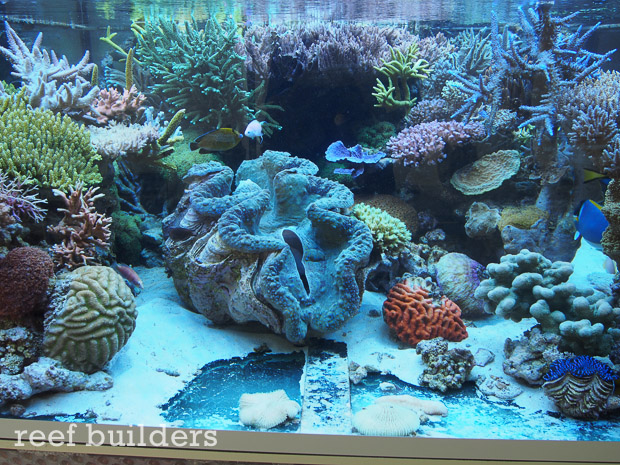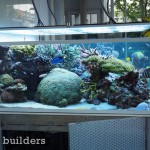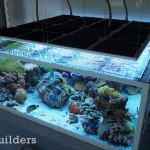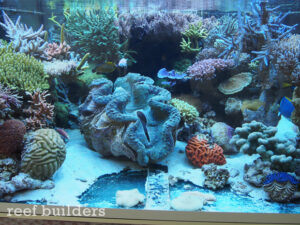Triton Reef has been attracting a lot of attention for their revolutionary approach to chemistry and novel water testing service, but behind the company are die hard hobbyists that really love reefing. The Triton Reef reef, is a lush garden of stony corals that surely outweigh the live rock used in the very natural aquascape, but the real star of Triton is the ginormous Tridacna gigas giant clam.
It’s one thing to grow corals big and lay down a ton of skeleton into large coral colonies but a giant, giant clam has even greater mineral and chemical demands. In the Triton Reef you can clearly see the growth of the shell in the three years this beast has super-sized each of its valves much bigger than a kitchen sink. The past three years of growth have been supported exclusively with Triton Reef Elementz and lit by the Triton Lani LED fixture.
 We’ve seen aquarium Gigas clams before, often times in huge exhibits wherein the clam doesn’t seem so large, nor does it often develop the beautiful metallic blue spotting that the Triton Reef clam has in abundance. But in the setting of this large reef tank, the jumbo Tridacna gigas absolutely dwarfs every coral, every invertebrate, and even the adult reef fish swimming around it appear to be miniatures.
We’ve seen aquarium Gigas clams before, often times in huge exhibits wherein the clam doesn’t seem so large, nor does it often develop the beautiful metallic blue spotting that the Triton Reef clam has in abundance. But in the setting of this large reef tank, the jumbo Tridacna gigas absolutely dwarfs every coral, every invertebrate, and even the adult reef fish swimming around it appear to be miniatures.
The only downside to keeping such a large giant clam so happy and healthy is that in time, the Gigas clam does what all animals are programmed to do, it spawns. When a one pound clam releases a little cloud of gametes into a large aquarium it’s cute. When a wheelbarrow sized mollusk decides it’s time to procreate in a confined aquarium, very bad things can happen to the water quality, fast.
Thankfully, the Triton Reef staff is intimately familiar with their pet giant clam and the gigas clam will actually “practice” the forceful ejection of its gametes for days before the actual release, and measures can be taken to mitigate the effect of a hundred million clam eggs from polluting the entire aquarium. Seeing a near-adult sized Tridacna gigas clam is a rare sight in the wild, and even more so in aquariums as the species is not currently being cultured. But if you ever get the chance to see one of these beastly bivalves up close and in person, it will give you a new found respect for the massive size these animals can grow to.











